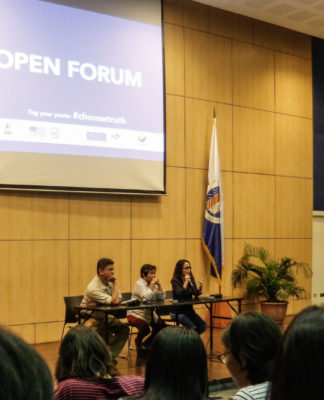FACULTY members will troop to the polling booths on Sept. 28 to elect a new set of union officials, amid lingering questions over the impact of the K to 12 scheme on job security and last year’s collective bargaining agreement (CBA) with the UST administration.
The incumbent president, Dr. George Lim, faces off with his former number two, longtime union executive Rene Luis Tadle, and Jove Jim Aguas for the top post in the 1,500-strong UST Faculty Union (USTFU).
Lim’s “Kabalikat” slate is running on a platform of continuity of programs and professionalization of the union, faculty unity, and “respect” for UST and its officials, while Tadle’s “Lead 4 Change Alliance” ticket wants “union transformation” and vows there will be “no teacher left behind.”
Aguas, a philosophy professor, is running as an independent on a platform of a “collaborative, collegial and proactive, rather than reactive” faculty union.
Lim’s party also vows to “maintain the utmost integrity in the performance of our duties; maintain transparency of all activities and transactions; distribute all excess funds to the membership equitably.”
Referendum on Lim?
The USTFU election is turning out to be a referendum on the tenure of Lim, who is part of the medical faculty. Last year, union negotiators led by Lim himself struck a new collective bargaining deal with the UST administration for the years 2011-2016, but not without acrimony.
The Lead 4 Change Alliance candidate for vice president for legal affairs, lawyer Danielito Jimenez of the Faculty of Arts and Letters, claims faculty members got the raw end of the deal under Lim’s CBA. Leave benefits in the new CBA are nothing to crow about as they are already mandated by existing laws, he said.
“These benefits under the CBA do not differ from the legally mandated labor standards and cannot therefore be considered a product of negotiation,” Jimenez said in an interview.
UST administrators, meanwhile, were able to get their way, particularly in the system of promotion and faculty classification.
“During the general assembly, I tried to raise the [concerns regarding CBA], but what happened that time was that they prevented us from raising concerns,” Jimenez claimed.
The CBA states that “a female faculty member is entitled to 60 days leave with full pay based on her gross monthly compensation” while “pregnant faculty members are entitled to maternity leave for a maximum of 60 days for normal delivery and 78 days for caesarian delivery.”
Also, “every male faculty member shall be entitled to a paternity leave of seven working days with full pay for the first four deliveries or miscarriages.”
Republic Acts 7322 and 8187, however, already mandate maternity and paternity leave benefits, respectively.
‘CBA a negotiation’
Jimenez said he would “push for better terms and conditions of employment over and above labor standards” should he win in the USTFU polls.
Lim acknowledged that some CBA provisions may not be “advantageous” to the faculty, but pointed out that it would be unrealistic to expect the union to obtain all of its demands during CBA talks.
“There are provisions that may not be to the advantage of the faculty members. We do not claim [that the CBA] is a perfect instrument. Hindi naman pwedeng lahat gusto nila, or lahat gusto namin [ang ilagay] kasi hindi na CBA `yon. CBA is a negotiation,” Lim said in an interview.
The CBA also performs the role of informing faculty members of their benefits, which is why benefits already mandated by law were included in last year’s deal, he added.
“There are so many benefits provided by law that the faculty members are not even aware of. If you do not put it there, [the more] they will not be aware of that information,” Lim said.
At any rate, Lim said USTFU officials never obliged members to ratify the document last year.
“The document is presented to everybody. We did not coerce anyone to vote for its ratification. So na-ratify `yan, more than 80 percent [voted for it],” Lim said.
K to 12 woes
Tadle, who quit the USTFU vice presidency to run against Lim, meanwhile scored the lack of immediacy in information dissemination to union members, particularly on University policies in relation to the K to 12 scheme.
A reduction of teaching loads is expected beginning 2016 as high school students will spend two more years in senior high school instead of graduating to college. UST has reduced its program offerings to just 13 from 56 for the next academic year.
“I think there is a need for a more assertive leadership and someone who is really knowledgeable regarding the things that must be done. Nakita ko talaga na may kakulangan sa policy in relation to K to 12 and I think we have to be more proactive in protecting the rights and interests of faculty members,” Tadle said in an interview.
Tadle’s Lead 4 Change Alliance promises to deal with problems concerning the K to 12 transition through a “trifocal approach”: urging the government to enact policies protecting faculty members, partnership and dialogue between the UST administration and the union to prevent job cuts, and coordination with non-government organizations like the Catholic Bishops’ Conference of the Philippines in upholding labor-friendly policies for faculty members that will be affected by the transition.
Transparency, full disclosure
Aguas is proposing to form a special committee to address K to 12 issues and another committee focused on CBA negotiations.
Aguas’ platform stresses the need for “advancement in academic excellence” through a support system for faculty research and publication as well as financial incentives. Aguas also vows to ensure “good governance and administration” through full disclosure of USTFU spending and the publication of yearly financial reports. C.I. Hormachuelos And K.J.V. Baylon
















Hi there, I wish for to subscribe for this website to obtain most
up-to-date updates, therefore where can i do it please assist.